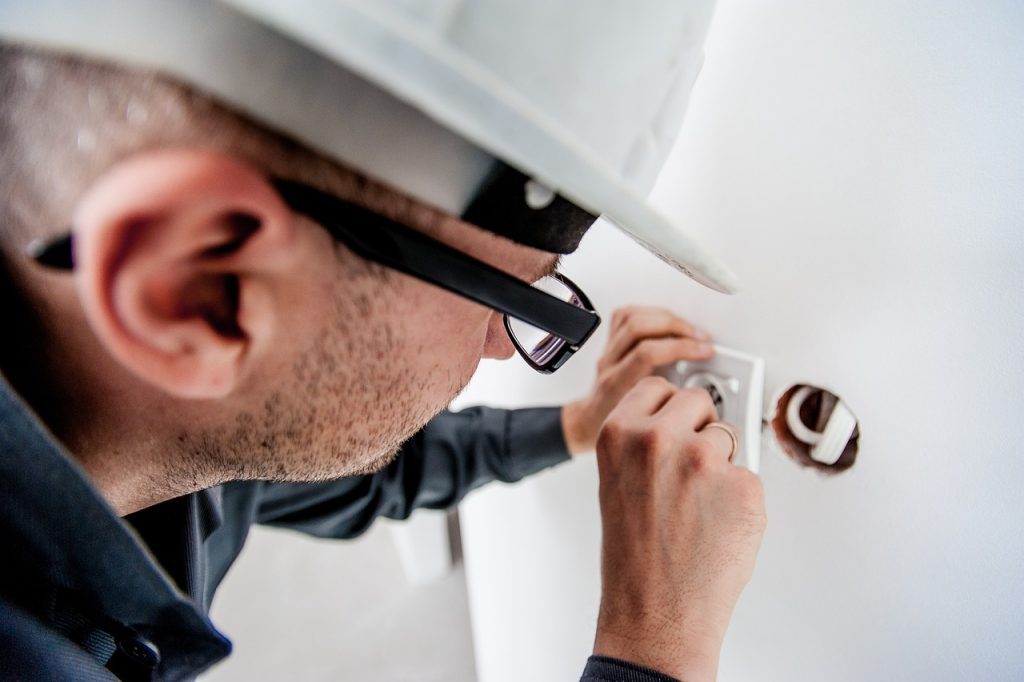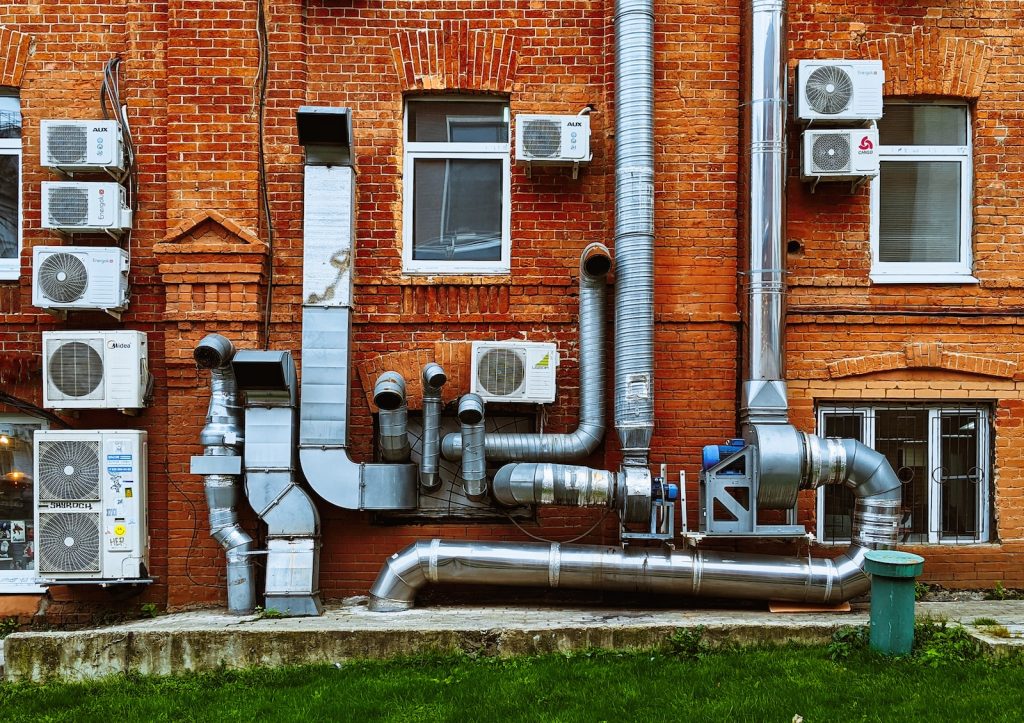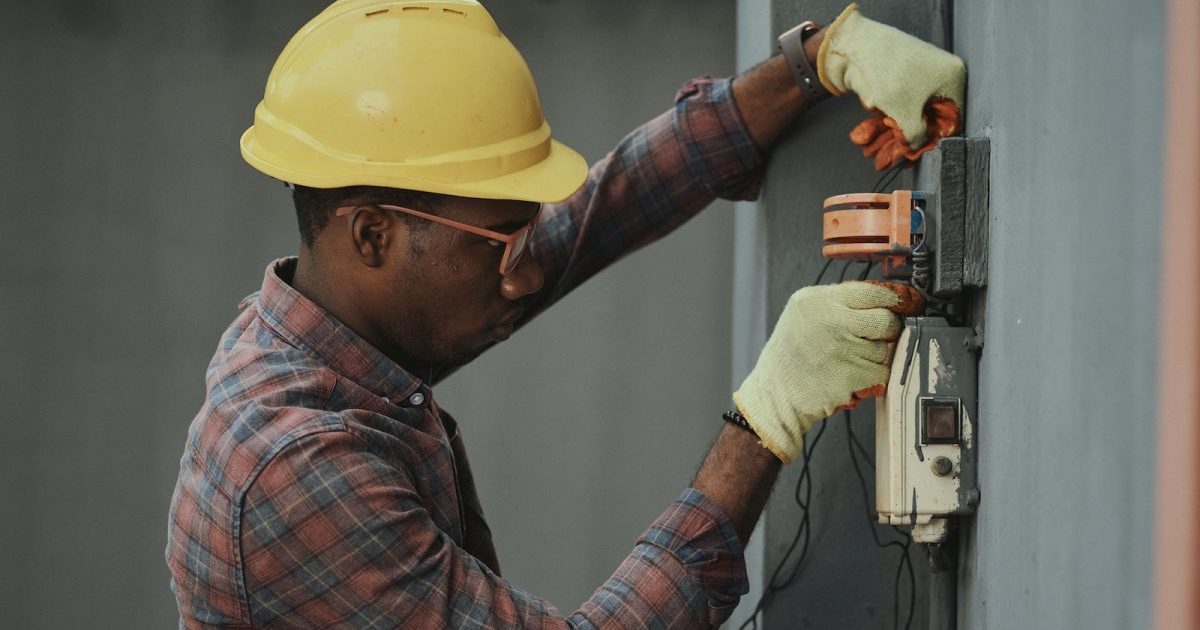Introduction
Are you curious about the term ‘M&E’ in construction and what it stands for? In the world of construction, M&E refers to Mechanical and Electrical services. These services are an integral part of any building project, ensuring that a structure is equipped with functioning mechanical systems such as heating, ventilation, and air conditioning (HVAC), as well as electrical systems like lighting and power distribution.
When it comes to construction projects, M&E plays a crucial role in creating functional and comfortable spaces. The Mechanical aspect focuses on the installation and maintenance of HVAC systems, plumbing, fire protection, and other mechanical components. On the other hand, the Electrical aspect deals with designing and implementing electrical wiring, lighting fixtures, power outlets, data cabling infrastructure, and security systems.
Understanding what M&E stands for is just the beginning. In this article, we will delve deeper into its significance within the construction industry. We will explore the difference between MEP (Mechanical, Electrical & Plumbing) and M&E services while also shedding light on what M&E engineers do and their qualifications. Additionally, we’ll discuss essential skills required for working in this field along with how M&E fits into project planning and management.
So let’s dive in to uncover all there is to know about M&E in construction!
What Does M&E Stand For in Construction?
So, you’re wondering what M&E stands for in construction? Well, let me tell you! M&E is short for Mechanical and Electrical, which are crucial components of any construction project.
M&E coordination involves the planning and management of mechanical and electrical systems to ensure they work seamlessly together. This includes coordinating the installation of HVAC (heating, ventilation, and air conditioning), plumbing, lighting, power distribution, and fire protection systems. M&E systems play a vital role in providing comfort, safety, and functionality to buildings. They need to comply with various regulations and standards to ensure they meet the required quality and safety standards.
M&E regulations govern the design, installation, operation, and maintenance of mechanical and electrical systems in construction projects. These regulations cover aspects such as energy efficiency requirements, fire safety measures, environmental considerations, and accessibility standards. Inspections are conducted throughout the construction process to ensure compliance with these regulations. Qualified inspectors review the M&E systems to verify their proper functioning and adherence to the established guidelines.
Another important aspect related to M&E in construction is cost estimation. Accurately estimating costs associated with mechanical and electrical works is essential for budgeting purposes. It involves analyzing factors such as material costs, labor expenses, equipment requirements, permit fees, and engineering services fees, among others. A thorough cost estimation helps in allocating resources efficiently while ensuring that all necessary components are included within the budget.
Now that you have a better understanding of what M&E stands for in construction, including its coordination processes like inspections or cost estimation; let’s move on to discussing the difference between MEP (Mechanical Electrical Plumbing) services compared to M&E services without skipping a beat!
What is The Difference Between MEP and M&E?
MEP and M&E have distinct differences in the construction industry. Understanding these differences is important for anyone involved in the field. Here are some key points to consider:
- Difference between MEP and M&E: MEP stands for Mechanical, Electrical, and Plumbing, while M&E stands for Mechanical and Electrical. The main difference lies in the inclusion of plumbing within MEP. While both involve the mechanical and electrical aspects of a construction project, MEP encompasses plumbing as well.
- Importance of M&E in construction: M&E plays a crucial role in ensuring that a building’s mechanical and electrical systems are designed, installed, and maintained properly. This includes everything from heating, ventilation, air conditioning (HVAC) systems to lighting, power distribution, fire protection systems, and more. Without effective M&E engineering, buildings wouldn’t function optimally or meet safety standards.
- Responsibilities of M&E engineers: M&E engineers are responsible for designing the mechanical and electrical systems in a building according to specific project requirements. They also oversee installation processes to ensure compliance with regulations and quality standards. Additionally, they conduct inspections during construction to identify any issues or potential risks that need addressing.
Mentioning ‘step’ without writing it.
Now that you understand the difference between MEP and M&E as well as the importance of M&E engineering in construction projects…
What Does M&E Engineer Do?
With their expertise in designing and overseeing installations, M&E engineers bring buildings to life through the intricate coordination of mechanical and electrical systems. These professionals play a crucial role in the construction industry by ensuring that all mechanical and electrical components work seamlessly together.

As M&E engineers, their responsibilities include designing heating, ventilation, and air conditioning (HVAC) systems, electrical distribution networks, fire protection systems, and other vital building services.
To become an M&E engineer, certain qualifications are necessary. Typically, individuals pursuing this career path hold a bachelor’s degree in either mechanical or electrical engineering. They also need to have a strong understanding of building regulations and codes to ensure compliance with safety standards. Additionally, excellent problem-solving skills and attention to detail are essential as M&E engineers often encounter complex challenges during the design process.
The importance of M&E in construction cannot be overstated. Without proper coordination of mechanical and electrical systems, buildings would lack functionality and efficiency. From providing adequate lighting to maintaining comfortable indoor temperatures, M&E engineers ensure that buildings meet the needs of occupants while minimizing energy consumption. Furthermore, their expertise contributes to sustainable building practices by implementing energy-efficient technologies.
Now that you understand the responsibilities and qualifications of an M&E engineer, let’s dive into what qualifications these professionals have when pursuing this rewarding career path.
What Qualifications Do M&E Engineers Have?
To embark on a rewarding career as an M&E engineer, you’ll need to possess a bachelor’s degree in mechanical or electrical engineering and have a strong understanding of building regulations and codes to ensure compliance with safety standards.
Did you know that 80% of M&E engineers also hold professional certifications such as Certified Energy Manager (CEM) or Leadership in Energy and Environmental Design (LEED)? These qualifications demonstrate their expertise in energy efficiency and sustainable design practices, which are becoming increasingly important in the construction industry.
In addition to formal education and certifications, M&E engineers also acquire valuable skills through practical experience. They are responsible for overseeing the design, installation, operation, and maintenance of mechanical and electrical systems within buildings. This includes HVAC systems, lighting systems, fire protection systems, plumbing systems, and more. M&E engineers must be familiar with the latest technologies and best practices in these areas to ensure optimal performance and energy efficiency.
A career as an M&E engineer offers promising job prospects. With the increasing focus on sustainability and energy efficiency in construction projects, there is a growing demand for professionals who can design and manage advanced mechanical and electrical systems. According to the Bureau of Labor Statistics, employment of mechanical engineers is projected to grow 4 percent from 2019 to 2029. The median annual wage for mechanical engineers was $88,430 in May 2020.
M&E engineers play a crucial role in ensuring the safe operation of buildings by overseeing their mechanical and electrical systems. Their qualifications enable them to navigate complex building regulations while implementing innovative technologies for increased energy efficiency.
Now that you understand what qualifications M&E engineers have, let’s explore the essential skills they need for success in their field: what are the M&E skills?
What are The M&E Skills?
M&E engineers possess a diverse range of skills that allow them to effectively design and manage mechanical and electrical systems in buildings. These skills are of utmost importance in the construction industry as they ensure the proper functioning and efficiency of these systems. M&E professionals need to have a strong understanding of engineering principles, as well as knowledge in areas such as HVAC (heating, ventilation, and air conditioning), plumbing, fire protection, and electrical systems. They must also be proficient in using computer-aided design (CAD) software to create detailed plans and layouts.
Challenges faced by M&E professionals in construction include staying up-to-date with constantly evolving technologies and regulations. As new innovations emerge, M&E engineers need to continuously enhance their skills and adapt their designs accordingly. Additionally, coordinating with other professionals involved in the construction process can be challenging, as there are often conflicting priorities and timelines. Effective communication and collaboration skills are therefore essential for M&E professionals to overcome these challenges.
Emerging trends in M&E practices in construction include the integration of sustainable technologies such as renewable energy sources, energy-efficient lighting systems, and smart building automation. As the world becomes more conscious about environmental impact, M&E engineers play a crucial role in designing eco-friendly buildings that minimize energy consumption while maximizing comfort for occupants. In addition to sustainable practices, advancements in Building Information Modeling (BIM) technology are revolutionizing how M&E professionals work by enabling better coordination between different disciplines involved in construction projects.
Looking toward the future prospects for M&E professionals in the construction sector, it is evident that their expertise will continue to be highly sought after. With increasing emphasis on green building initiatives and energy conservation efforts worldwide, there will be a growing demand for skilled M&E engineers who can contribute to sustainable development. Moreover, as technology continues to advance at a rapid pace within the field of construction, those with strong digital skills will have an edge over others.
Now that we’ve explored the importance of M&E skills in construction, let’s delve into the role of M&E in planning and how it contributes to the overall success of a project.
What is the Role of M&E in Planning?
The role of M&E in planning is crucial for the successful execution of construction projects, as it ensures seamless coordination and efficient utilization of resources.
One key importance of M&E in infrastructure development is that it allows project managers to monitor progress and identify any potential issues or bottlenecks early on. By regularly evaluating the project’s performance against predefined targets and objectives, M&E helps to keep projects on track and within budget. It also provides valuable insights into the effectiveness of different planning strategies, allowing for adjustments to be made if necessary.
However, incorporating M&E in planning does come with its challenges. One common challenge is the lack of standardized metrics and indicators across different projects. This makes it difficult to compare data accurately and measure progress consistently. Additionally, gathering reliable data can be time-consuming and resource-intensive, especially when dealing with large-scale construction projects. Despite these challenges, implementing effective strategies for M&E in construction projects is essential for ensuring their success.
Integrating M&E into project management brings several benefits. Firstly, it enables better decision-making by providing real-time information about project performance and identifying areas that require attention or improvement. Secondly, it improves accountability by establishing clear targets and benchmarks that hold all stakeholders accountable for their roles in the project’s success. Lastly, effective M&E allows for continuous learning and improvement throughout the planning process.
Technology plays a vital role in enhancing M&E in both the planning and construction phases. The use of digital tools such as project management software, sensors, drones, and data analytics enables more accurate data collection, analysis, and reporting. These technologies enhance efficiency by automating certain tasks while providing real-time updates on progress. With technology advancements continually evolving within the industry, integrating M&E into planning processes will only become more streamlined and effective.
Moving forward to the next section about whether M&E is part of project management, let’s explore how these two concepts intertwine seamlessly for successful construction endeavors.
Is M&E Part of Project Management?
Project management and monitoring and evaluation (M&E) go hand in hand, ensuring successful construction projects by providing real-time information, accountability, and continuous learning. M&E plays a crucial role in project management within the construction industry. Here are some key ways in which M&E is integrated into project management:
- M&E in project management: M&E helps project managers track progress, identify potential risks, and make informed decisions throughout the construction process. By monitoring key indicators such as cost, schedule, quality, and safety, M&E ensures that projects stay on track and meet their objectives.
- M&E engineer responsibilities: M&E engineers are responsible for planning and coordinating all aspects related to monitoring and evaluating a construction project. They design data collection systems, analyze data to assess progress, recommend improvements based on findings, and ensure compliance with relevant regulations.
- M&E engineer qualifications: To excel in this role, an M&E engineer needs a strong foundation in engineering principles as well as knowledge of data analysis techniques. They should also possess excellent communication skills to effectively collaborate with different stakeholders involved in the project.
- M&E planning and coordination: Effective planning is essential for the successful implementation of an M&E system. This involves defining clear objectives, establishing performance indicators, determining appropriate methods for data collection and analysis, and assigning responsibilities to various team members.
By integrating M&E into project management practices within the construction industry, companies can ensure that their projects are executed efficiently while continuously improving processes based on real-time feedback. With this understanding of how vital M&E is in project management within construction projects, let’s now delve into what is meant by ‘M&E maintenance’ without further ado.
What Is M&E Maintenance?
You might be wondering what exactly is involved in maintaining the monitoring and evaluation (M&E) system for a construction project. M&E maintenance refers to the ongoing efforts to keep the M&E system in optimal condition throughout the duration of the project.
This includes preventive maintenance, which involves regular inspections, servicing, and repairs of equipment used for data collection and analysis. It also entails developing and implementing maintenance schedules and procedures to ensure that all aspects of the M&E system are functioning properly.
One key aspect of M&E maintenance is equipment maintenance. This involves keeping track of all the equipment used in data collection, such as sensors, monitors, and software programs. Regular inspections are conducted to identify any issues or potential problems with the equipment. Preventive measures are then taken to address these issues before they can cause disruptions or inaccuracies in data collection.
Maintenance scheduling is another important component of M&E maintenance. This involves creating a schedule for regular inspections and servicing based on the specific needs of each piece of equipment. By adhering to a well-planned schedule, potential problems can be identified early on and appropriate actions can be taken promptly.
Incorporating effective maintenance procedures is crucial for ensuring that the M&E system operates smoothly. These procedures outline step-by-step instructions for routine inspections, servicing tasks, troubleshooting common issues, and repairing faulty components. Following these procedures helps maintain consistency in how maintenance tasks are performed across different stages of the construction project.
As you delve deeper into understanding M&E maintenance, it’s worth exploring how contractors specializing in this field play a vital role in managing such tasks efficiently without overwhelming your team with additional responsibilities.
M&E Maintenance Contractors
Hiring M&E maintenance contractors can greatly streamline the management of essential tasks, allowing your team to focus on core responsibilities. These contractors specialize in providing M&E maintenance services for various construction projects, ensuring that all mechanical and electrical systems are functioning optimally. By outsourcing this aspect of the project to experienced professionals, you can rest assured that your facility will be well-maintained while minimizing downtime and reducing costs.

M&E maintenance contractors offer a range of services to meet the specific needs of your project. They have extensive knowledge and expertise in maintaining mechanical systems such as HVAC (heating, ventilation, and air conditioning), plumbing, and fire protection systems. Additionally, they are skilled in handling electrical systems including lighting, power distribution, and backup generators. With their comprehensive understanding of these complex systems, they possess the necessary skills to diagnose issues efficiently and provide effective solutions.
When considering different m&e maintenance companies for your project, it is important to evaluate their experience and track record in similar projects. Look for contractors who have successfully completed m&e maintenance projects in various industries such as commercial buildings, hospitals, or industrial facilities. Additionally, consider their reputation for delivering high-quality work within budget and on time. While cost is an important factor when choosing a contractor, it is equally crucial to prioritize quality to ensure the longevity and reliability of your facility’s mechanical and electrical systems.
To give you a better understanding of how hiring M&E maintenance contractors can benefit your construction project, here is a table outlining some key advantages:
| Advantages | Explanation |
|---|---|
| Expertise | M&E maintenance contractors possess specialized knowledge in maintaining mechanical and electrical systems. Their expertise ensures efficient problem-solving and reduces downtime during repairs or replacements. |
| Cost Savings | Outsourcing M&E maintenance allows you to avoid investing in expensive equipment or training for your own staff members. Contractors often offer competitive pricing options, helping you minimize maintenance costs in the long run. |
| Focus on Core Responsibilities | By entrusting M&E maintenance to professionals, your team can focus on their core responsibilities without being burdened by additional tasks. This results in increased productivity and overall efficiency of your construction project. |
| Timely Maintenance and Issue Resolution | M&E maintenance contractors prioritize timely inspections, repairs, and replacements to ensure that any issues are addressed promptly. This proactive approach minimizes disruptions and helps maintain the smooth operation of your facility. |
By hiring reliable M&E maintenance contractors, you can effectively manage the upkeep of mechanical and electrical systems in your construction project. Their expertise, cost savings, and ability to focus on core responsibilities make them an invaluable asset to any construction team. Consider partnering with experienced contractors who have a proven track record in delivering high-quality work within budget and on time for successful project outcomes.
Frequently Asked Questions (FAQ)
What are the common challenges faced by M&E engineers in construction projects?
As an M&E engineer in construction, you face common challenges like time management, coordination issues, budget constraints, quality control, and technical complexities. These obstacles can be overwhelming but are essential to overcome for project success.
How does M&E engineering impact the overall cost of a construction project?
M&E engineering has a significant impact on the overall cost of a construction project. Through value engineering, budget management, cost optimization, and cost control, M&E engineers help minimize expenses and ensure that the project stays within budget.
Can you provide examples of real-life projects where M&E played a critical role?
M&E plays a critical role in construction projects. It’s like the backbone that supports the whole operation. From skyscrapers to hospitals, successful M&E implementations ensure everything runs smoothly, saving time and money.
What are the emerging trends in M&E engineering in the construction industry?
Emerging technologies and innovative solutions are transforming M&E engineering in construction. Digital transformation and automation are revolutionizing processes, while smart buildings integrate advanced systems for enhanced efficiency, sustainability, and occupant comfort.
How does M&E engineering contribute to sustainability and energy efficiency in buildings?
Energy management, renewable integration, building automation, and green technologies are all key aspects of M&E engineering. By implementing sustainable design principles, M&E engineers contribute to energy efficiency in buildings, reducing carbon emissions and promoting a more environmentally friendly future.
Conclusion
In conclusion, M&E stand for in construction for Mechanical and Electrical. It’s an integral part of any building project, ensuring the smooth operation of mechanical systems like HVAC and electrical systems such as lighting and power distribution.
MEP is often used interchangeably with M&E, although there may be slight variations in scope depending on the region or organization. M&E engineers play a crucial role in designing, installing, and maintaining these essential systems throughout the life cycle of a building. They possess qualifications such as engineering degrees or certifications related to their specific field of expertise. They also have a wide range of skills including problem-solving, technical knowledge, and project management abilities.
The role of M&E in planning cannot be overstated. Effective coordination between architects, contractors, and M&E engineers ensures that all mechanical and electrical requirements are incorporated into the design from the outset. This proactive approach minimizes costly changes or delays during construction.
Now, imagine a world without M&E maintenance. Buildings would be plagued by constant breakdowns and inefficiencies. The comfort we take for granted in our homes and workplaces would be compromised. Relying solely on reactive repairs would lead to higher costs and inconveniences for occupants.
So next time you step into a well-designed building with smoothly functioning mechanical and electrical systems, ask yourself – could it have been achieved without M&E?






